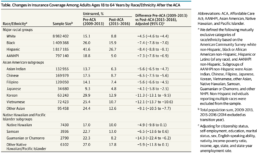
Twelve years ago on March 23, 2010, the Patient Protection and Affordable Care Act (ACA) was signed into law by President Barack Obama. The expansive law included provisions such as an expansion of Medicaid eligibility and the introduction of a health insurance marketplace with federal subsidies to help low-income Americans afford health insurance. Since then, the uninsured rate among non-elderly adults has fallen nearly 40% from 17.8% in 2010 to 10.9% in 2019 according to analyses by the Kaiser Family Foundation.
During this weeklong celebration of the ACA hosted by The White House and the Department of Health and Human Services, APAMSA highlights the impact of the ACA on the AANHPI communities. In a 2018 publication by John J. Park et al. in JAMA Internal Medicine, the authors found that the AANHPI uninsured rate fell by more than one half from 18.8% before the ACA to 9.0% by 2015-2016. In particular, the study examined differences by AANHPI subgroup. Korean Americans, who had the highest pre-ACA uninsured rate at 29.9%, saw their uninsured rate fall an adjusted 11.3 percentage points. Guamanian or Chamorro Americans saw a 14.3 percentage point adjusted reduction in their uninsured rate. In context, the ACA nearly eliminated the coverage gap between white and ANHPI Americans. Still, 7.4% of AANHPIs remained uninsured as of 2019 with uninsured rates for other race and ethnic groups as high as 20% for Hispanic Americans. Thus, the ACA may have significantly reduced the coverage gap, but it is clear that substantial work remains to achieve universal equitable health coverage for AANHPI communities and all Americans — a goal APAMSA remains steadfastly committed to realizing in our advocacy.